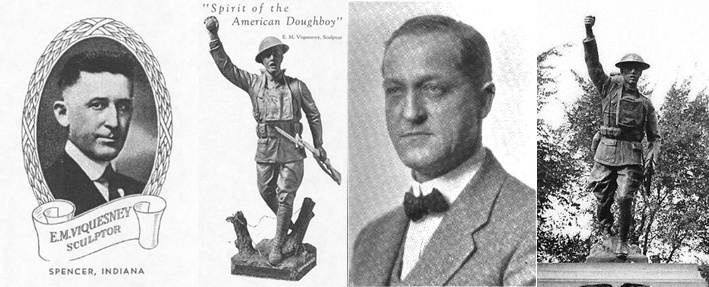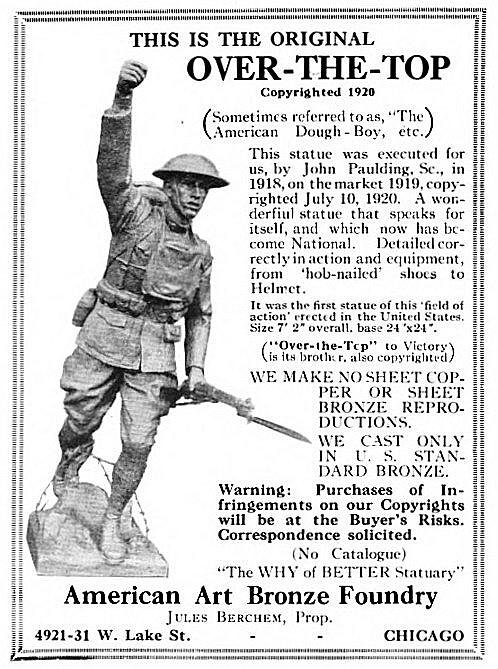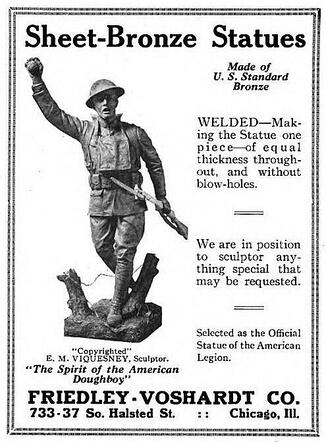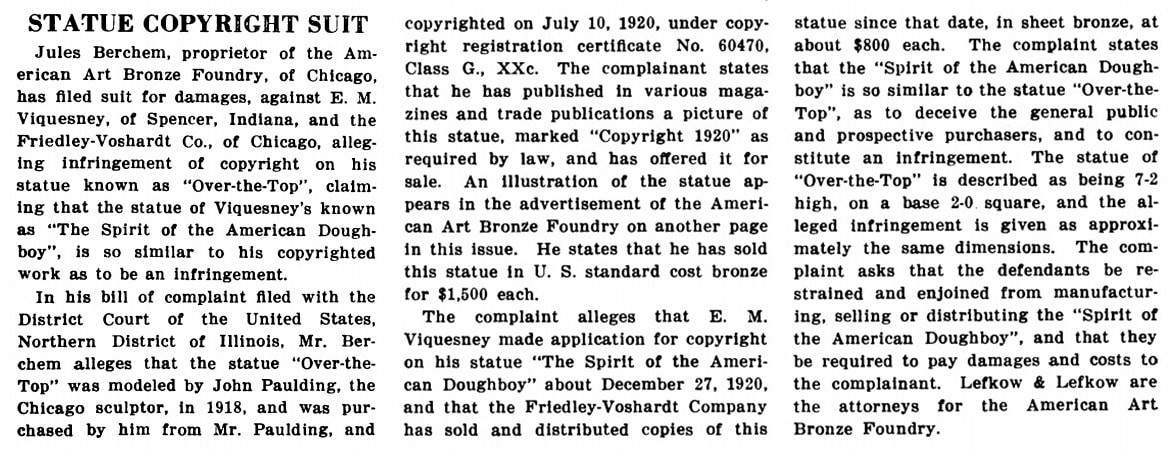|
|
A DOUGHBOY AD WAR:
E.M. VIQUESNEY VS. JOHN PAULDING
"Don't be fooled -- Insist on a Viquesney Doughboy for your memorial."
-- From a 1929 ad for Viquesney's Doughboy.
"Are you fooled? Not with genuine cast bronze."
-- From a competing ad for John Paulding's Doughboy.
Above: American Art Bronze Foundry, producer of John Paulding's "Over the Top", and Friedley-Voshardt Company, manufacturer of E. M. Viquesney's "Spirit of the American Doughboy", battled it out in the pages of various trade journals throughout the 1920s. Note the bold print in the AABF ad warning of dire consequences to anyone violating their copyright, a direct shot at purchasers of Viquesney's statue. AABF eventually sued Viquesney and Friedley-Voshardt for copyright infringement in April, 1922.
The outcome of the lawsuit isn't known, but earlier in the year, in January of 1922, perhaps in anticipation of the suit and the need to raise funds for a possible out-of-court settlement, Viquesney suddenly and mysteriously sold all right and interest in his Doughboy to his friend and business partner Walter Rylander, who then owned Viquesney's Doughboy company for the next four years. Viquesney was eventually able to buy back his Doughboy in 1926 and continued to produce it until the start of WWII.
SCULPTOR JOHN PAULDING’S DOUGHBOYS
EARL D. GOLDSMITH, THE WOODLANDS, TEXAS
[Editor's note: Earl passed away March 6, 2018.]
EARL D. GOLDSMITH, THE WOODLANDS, TEXAS
[Editor's note: Earl passed away March 6, 2018.]
A matter that’s added to the difficulty in compiling a correct list of Viquesney Doughboy locations is that several other sculptors created Doughboy statues, some rather similar to "The Spirit of the American Doughboy". The Doughboys of sculptor John Paulding (1883 - 1935), carrying the theme title "Over the Top", are the most prevalent of these. I estimate there are 50 - 55 Pauldings, many of which have been misidentified as Viquesneys, including some in the Smithsonian Inventory of American Sculpture. The information that follows describes similarities between the Pauldings and the Viquesneys, as well as features that help distinguish them from one another.
Both have an upraised right hand. While that’s probably been the major reason for many erroneous identifications, there are many more similarities. Most Pauldings have rifles in their left hands pointed forward at about hip height, usually with an affixed bayonet, as do Viquesneys. Both have flat round helmets, bloused trousers and puttees (wrapped leggings), all of the types worn in the war, a cartridge belt, a field pack on their back, and a gas mask pouch on their chest. Both have (or at least originally had) barbed wire at their feet and appear to be advancing through "no man’s land". It’s not surprising that they’ve been mistaken for one another.
Both have an upraised right hand. While that’s probably been the major reason for many erroneous identifications, there are many more similarities. Most Pauldings have rifles in their left hands pointed forward at about hip height, usually with an affixed bayonet, as do Viquesneys. Both have flat round helmets, bloused trousers and puttees (wrapped leggings), all of the types worn in the war, a cartridge belt, a field pack on their back, and a gas mask pouch on their chest. Both have (or at least originally had) barbed wire at their feet and appear to be advancing through "no man’s land". It’s not surprising that they’ve been mistaken for one another.
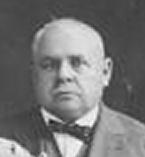 Jules Berchem
Jules Berchem
In fact, they were similar enough in the mind of Jules Berchem (left), the owner of American Art Bronze Foundry in Chicago, Illinois (the foundry Paulding used), that he sued Viquesney and Friedley-Voshardt Company in 1922 for copyright infringement, claiming Viquesney's and Paulding's statues were "so similar as to deceive the general public". Even years later, Viquesney and AABF were still carrying on an ad war (see sub-headers above), with the latter touting the superiority of genuine cast bronze over Viquesney's cheaper stamped sheet bronze. Thus, if the statue you are looking at has an American Art Bronze Foundry logo on the base, it is not a Viquesney Doughboy.
When viewed from the side, the differences between Viquesney and Paulding Doughboys become readily apparent. Paulding's Doughboys have a crouched, running or charging mode rather than the erect striding mode of Viquesney's statues. The Paulding left knee is noticeably bent, whereas the Viquesney left knee is straight. The Paulding right leg extends in a running mode, and the right foot is clear of the base. While the Viquesney right knee is bent and the right heel is raised, the toe of the right shoe is in contact with the base. Viquesney Doughboys have a flat rectangular pack over a bedroll, whereas Pauldings have a more vertical and round bedroll. Metal Viquesney Doughboys have two tree stumps on the base; Pauldings have a strangely shaped brace supporting the right leg just below the knee. This brace is the Paulding "hallmark" that distinguishes any "Over the Top" statue from Viquesney's "Spirit of the American Doughboy". Thus, if the right foot is clear of the base with the right leg supported by a brace, the statue you are looking at is not a Viquesney Doughboy.
But so pervasive was Viquesney's influence over the genre, that many communities that possess a Paulding statue still to this day believe they have a copy of Viquesney's "Spirit of the American Doughboy", and in at least one case a plaque was even put up attesting to this "fact", at Leavenworth, Kansas. In 2001, when their Doughboy statue was refurbished by the Disabled American Veterans, a plaque was placed honoring them for their work on Leavenworth's "Spirit of [the] American Doughboy" statue --- except Leavenworth's Doughboy is Paulding's "Over the Top to Victory", complete with open right hand (no grenade), right leg brace and American Art Bronze Foundry logo.
Ed. note: Leavenworth has since recognized the error, but the 2001 plaque with the wrong name still remains.
All known Paulding "Over the Top" Doughboys occur in four versions, designated Model 2043-A through D, and are identical except as to the design of the raised right hand. The Model A, "Over the Top", copyrighted in 1920 and 1921, was the first, and exhibits the clenched right fist as shown in the ad above, left. The B through D models followed shortly thereafter, beginning with "Over the Top to Victory", which displays an open right hand. Examples of it can be seen at Chillicothe, OH and Winner, SD. The C model, "Over the Top at Cantigny", waves its rifle aloft in the right hand (Astoria, OR), and the D model holds a grenade (Buffalo, NY), making it the one that most resembles Viquesney's Doughboy. It, too, is called "Over the Top to Victory". Only two each of the "C" and "D" models are known to exist. The other "C" model is at Catskill, NY, and the other "D" model is at Salem, OR.
When viewed from the side, the differences between Viquesney and Paulding Doughboys become readily apparent. Paulding's Doughboys have a crouched, running or charging mode rather than the erect striding mode of Viquesney's statues. The Paulding left knee is noticeably bent, whereas the Viquesney left knee is straight. The Paulding right leg extends in a running mode, and the right foot is clear of the base. While the Viquesney right knee is bent and the right heel is raised, the toe of the right shoe is in contact with the base. Viquesney Doughboys have a flat rectangular pack over a bedroll, whereas Pauldings have a more vertical and round bedroll. Metal Viquesney Doughboys have two tree stumps on the base; Pauldings have a strangely shaped brace supporting the right leg just below the knee. This brace is the Paulding "hallmark" that distinguishes any "Over the Top" statue from Viquesney's "Spirit of the American Doughboy". Thus, if the right foot is clear of the base with the right leg supported by a brace, the statue you are looking at is not a Viquesney Doughboy.
But so pervasive was Viquesney's influence over the genre, that many communities that possess a Paulding statue still to this day believe they have a copy of Viquesney's "Spirit of the American Doughboy", and in at least one case a plaque was even put up attesting to this "fact", at Leavenworth, Kansas. In 2001, when their Doughboy statue was refurbished by the Disabled American Veterans, a plaque was placed honoring them for their work on Leavenworth's "Spirit of [the] American Doughboy" statue --- except Leavenworth's Doughboy is Paulding's "Over the Top to Victory", complete with open right hand (no grenade), right leg brace and American Art Bronze Foundry logo.
Ed. note: Leavenworth has since recognized the error, but the 2001 plaque with the wrong name still remains.
All known Paulding "Over the Top" Doughboys occur in four versions, designated Model 2043-A through D, and are identical except as to the design of the raised right hand. The Model A, "Over the Top", copyrighted in 1920 and 1921, was the first, and exhibits the clenched right fist as shown in the ad above, left. The B through D models followed shortly thereafter, beginning with "Over the Top to Victory", which displays an open right hand. Examples of it can be seen at Chillicothe, OH and Winner, SD. The C model, "Over the Top at Cantigny", waves its rifle aloft in the right hand (Astoria, OR), and the D model holds a grenade (Buffalo, NY), making it the one that most resembles Viquesney's Doughboy. It, too, is called "Over the Top to Victory". Only two each of the "C" and "D" models are known to exist. The other "C" model is at Catskill, NY, and the other "D" model is at Salem, OR.
A LIST OF SOME PAULDING DOUGHBOY LOCATIONS
The following list shows a few of the approximately 55 locations of John Paulding's "Over the Top" series of WWI Doughboy memorials: Jonesboro, AR; Manitou Springs, CO; Palmer Park, Chicago, IL (now gone); Elgin, IL; Freeburg, IL; Wheaton, IL; Onaga, KS; Leavenworth, KS; Williamsport, MD; South Haven, MI; Albany, MO; Marshall, MO; Missoula, MT; Wahpeton, ND; Valentine, NE; Bolton Landing, NY; Buffalo, NY; Catskill, NY; Chillicothe, OH; Camp Washington (Cincinnati), OH; Astoria, OR; McMinnville, OR, Salem, OR; Philadelphia, PA; Newberry, SC; Winner, SD; Knoxville, TN; Llano, TX; Ladysmith, WI; Wautoma, WI; Evanston, WY.
In addition to the previously mentioned Doughboy at Leavenworth, KS, the Doughboy at Llano, TX, is misidentified at .warmemorialhq.org and dreamstime.com.
There are other Paulding Doughboys, but I've only included links with photos. There's a YouTube movie featuring the Missoula, MT statue which correctly differentiates it from Viquesney's "Spirit of the American Doughboy", but misspells his name as Visquesney (a common error).
In addition to the previously mentioned Doughboy at Leavenworth, KS, the Doughboy at Llano, TX, is misidentified at .warmemorialhq.org and dreamstime.com.
There are other Paulding Doughboys, but I've only included links with photos. There's a YouTube movie featuring the Missoula, MT statue which correctly differentiates it from Viquesney's "Spirit of the American Doughboy", but misspells his name as Visquesney (a common error).
Editor's note: Why aren't the Doughboy statues by John Paulding included in our Lookalikes section? Because it's the Viquesney Doughboy that's the lookalike. John Paulding beat E. M. Viquesney to the copyright office by five months in July, 1920, which might have been the basis for a copyright infringement lawsuit filed against Viquesney in 1922 (see below). But by using flamboyant advertising and sales tactics, and cheaper materials and construction methods, Viquesney was soon able to overshadow Paulding, unfortunately leading to the misconception in later years that Paulding was the "copycat". And perhaps to his discredit, Viquesney helped matters little when he introduced a new version of his Doughboy the same year Paulding died (1935). The title? "Over the Top", the same title Paulding used for his series of Doughboy statues. As far as known, it was only produced as a miniature.
